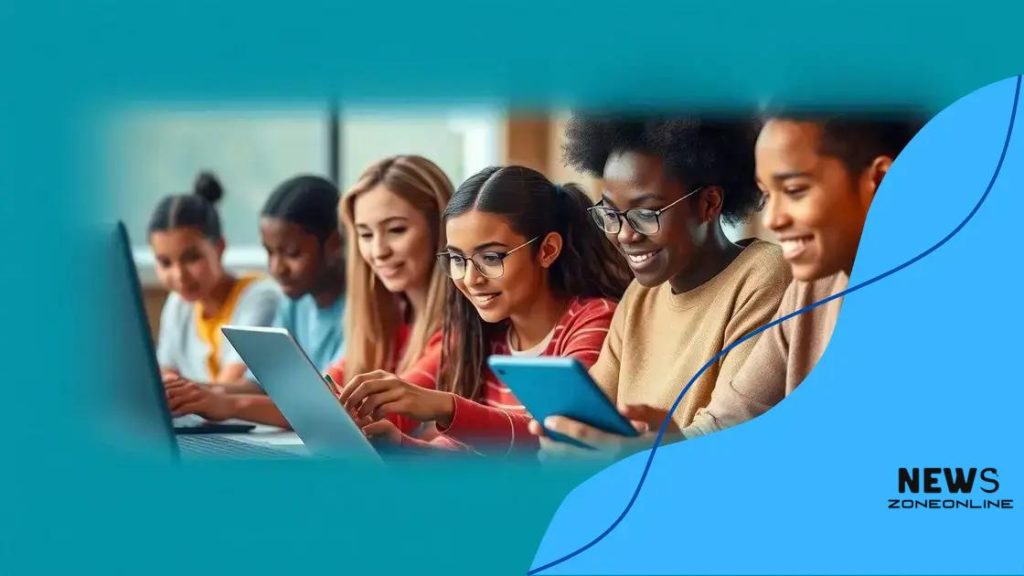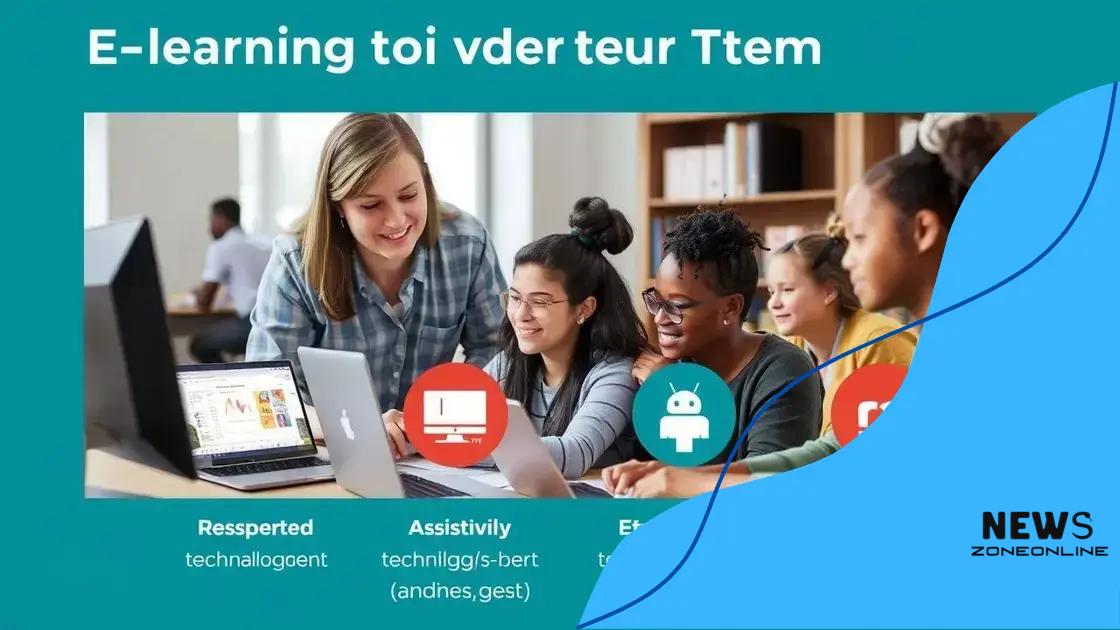Accessibility mandates for e-learning: what you need to know

Accessibility mandates for e-learning ensure that educational content is available to all students, promoting inclusivity and engagement by utilizing strategies like AI, Universal Design for Learning, and immersive technologies.
Accessibility mandates for e-learning are becoming increasingly important as digital learning platforms grow. Have you ever considered how these requirements impact your learning experience? Let’s dive into the essentials.
Understanding accessibility mandates in e-learning
Understanding accessibility mandates in e-learning is crucial for creating an inclusive environment. These mandates ensure that all learners can participate effectively, regardless of their abilities. As e-learning expands, the importance of these guidelines only grows.
What Are Accessibility Mandates?
Accessibility mandates are laws and regulations designed to support students with disabilities. These rules aim to remove barriers that prevent equal access to online education. They focus on various aspects, including technology, design, and content delivery. By following accessibility mandates, institutions can create learning materials that everyone can use.
Key Principles of Accessibility
When developing e-learning content, it’s vital to consider several key principles:
- Perceivable: Information must be presented in ways that all learners can perceive it.
- Operable: Users should be able to navigate and control content easily.
- Understandable: Content must be clear and logical for effective learning.
- Robust: The content should work across various devices and assistive technologies.
Accessibility is not just about following rules; it’s about fostering an environment of trust and support among learners. By emphasizing accessibility, educators can enhance student engagement and improve outcomes. Moreover, accessible content promotes independence, allowing learners to explore materials at their own pace.
Incorporating accessibility into e-learning also involves continuous improvement. Feedback from users with disabilities can guide enhancements in content delivery. By prioritizing their needs, educators can refine e-learning experiences and make education truly inclusive.
Key benefits of implementing accessibility standards
Implementing accessibility standards in e-learning provides a wide range of benefits for both educators and learners. These standards ensure that all individuals can access and engage with educational content. By prioritizing accessibility, institutions create an inclusive environment that fosters learning for everyone.
Enhancing Student Engagement
One of the primary benefits of accessibility standards is improved student engagement. When educational materials are accessible, more students can participate fully in the learning process. This leads to greater interaction and collaboration among peers.
Wider Reach of Educational Content
Accessibility standards also expand the reach of educational content. By making learning materials usable for everyone, including those with disabilities, institutions can attract a wider audience. This inclusivity not only benefits students but also enhances the institution’s reputation.
- Increased enrollment: More learners are likely to enroll when they see that resources are accessible.
- Diverse learning styles: Accessible materials cater to various learning preferences, improving overall understanding.
- Positive feedback: Students appreciate institutions that value accessibility, leading to higher satisfaction rates.
Additionally, following accessibility standards ensures compliance with legal requirements. Non-compliance can result in lawsuits and damage to an institution’s credibility. By proactively implementing these standards, educators can avoid potential legal issues while promoting a positive learning environment.
Moreover, accessible e-learning content often benefits everyone, not just students with disabilities. For example, captions in videos assist those learning a new language, while text-to-speech features help auditory learners. This universal approach enhances the educational experience for all students, laying the foundation for a more adaptable and effective learning platform.
Common challenges faced by e-learning providers

Common challenges faced by e-learning providers can significantly impact the effectiveness of digital education solutions. As online learning continues to expand, understanding these challenges becomes essential for delivering quality education. One major issue is ensuring that all learning materials are compliant with accessibility mandates.
Adapting Content for Diverse Learners
Creating content that meets the needs of all learners can be a complex task. E-learning providers must consider various disabilities and learning styles. This means incorporating features like captions, audio descriptions, and alternative text effectively. Additionally, keeping up with technological updates and accessibility standards can be overwhelming.
Technical Limitations
Another challenge is the technical limitations of some platforms. Not all e-learning systems are built with accessibility in mind. Providers must regularly assess their technology to ensure it accommodates assistive tools such as screen readers and speech recognition software. The lack of integration can hinder a learner’s ability to use the platform effectively.
- Budget constraints: Limited funding can restrict the ability to upgrade technology or hire experts in accessibility.
- Lack of training: Educators may not receive proper training on how to create accessible content.
- Resistance to change: Some institutions may struggle to adapt to new standards and strategies.
Additionally, gathering feedback from users can be challenging, especially if learners feel uncomfortable reporting their difficulties. E-learning providers need to create a supportive environment where all students feel safe to share their experiences. This feedback is crucial for improving accessibility measures.
Lastly, the constantly evolving nature of technology presents another hurdle. E-learning providers must stay informed about the latest tools and best practices in accessibility. This requires ongoing education and adaptation, which can be resource-intensive but is necessary for maintaining an inclusive learning environment.
Strategies for effective compliance with mandates
Strategies for effective compliance with mandates are essential for e-learning providers aiming to create accessible content. These strategies help ensure that all learners, regardless of their abilities, can benefit from educational resources. Implementing these strategies can transform the learning experience for many.
Understanding Current Regulations
The first step in compliance is understanding the current accessibility regulations. E-learning providers must become familiar with laws such as the Americans with Disabilities Act (ADA) and Section 508 of the Rehabilitation Act. These regulations outline the requirements for accessible online content. Being informed enables institutions to align their practices with legal standards.
Conducting Regular Audits
Conducting regular audits of e-learning materials is crucial. By reviewing content against accessibility checklists, providers can identify and address areas needing improvement. Regular audits help keep materials up to date and ensure that they meet the necessary accessibility standards.
- Use of accessibility tools: Employ tools that assess accessibility features in multimedia, such as video captions and screen reader compatibility.
- Gather feedback: Collect feedback from users with disabilities to pinpoint specific challenges they face when accessing materials.
- Training staff: Provide training for educators and content creators on best practices for developing accessible resources.
Additionally, fostering a culture of accessibility within the organization is key. Encourage collaboration among staff to share knowledge and resources focused on accessibility. When everyone is on the same page regarding compliance, it enhances overall effectiveness.
It’s also beneficial to establish a clear plan for monitoring and updating e-learning content. As technologies evolve, so too should the approaches to accessibility. This proactive strategy ensures compliance and supports continuous improvement in educational experiences.
Future trends in accessibility for online education
Future trends in accessibility for online education are shaping the landscape of e-learning. As technology advances, it’s essential to stay ahead and incorporate these trends into educational practices. One significant trend is the increased use of artificial intelligence (AI) to assist learners.
Artificial Intelligence in Education
AI can help customize learning experiences for individuals with disabilities. Tools powered by AI can analyze a student’s needs and adapt content accordingly. For instance, AI can provide personalized learning paths and real-time feedback, enhancing engagement and comprehension.
Universal Design for Learning (UDL)
Another emerging trend is the adoption of Universal Design for Learning (UDL). This approach ensures that instructional goals, methods, materials, and assessments are adaptable to a wide range of learners. By embedding UDL principles in online courses, educators can create more inclusive environments for all students.
- Flexibility in assessments: Providing options for how students can demonstrate their knowledge encourages participation.
- Diverse content delivery: Incorporating videos, audio, and interactive media caters to different learning styles.
- Continuous training: Educators will need ongoing training to stay updated on best practices and technological advancements.
Additionally, mobile accessibility is becoming increasingly important. With more students using smartphones and tablets for learning, ensuring that educational apps and websites are mobile-friendly is crucial. This adaptability can improve access for students who face challenges with traditional desktop environments.
Furthermore, the integration of virtual and augmented reality (VR and AR) technologies offers exciting possibilities for accessible learning experiences. These technologies can provide immersive environments that cater to various learning needs. VR can simulate real-life scenarios, while AR can enhance traditional learning by overlaying information in the real world.
FAQ – Questions about Accessibility in E-learning
How can accessibility benefit all students in e-learning?
Accessibility ensures that all students can participate fully in learning, allowing diverse learners to engage and succeed.
What role does artificial intelligence play in making education more accessible?
AI personalizes learning experiences, helping to adapt content and methods to meet individual student needs.
Why is Universal Design for Learning (UDL) important in online education?
UDL supports a wide range of learners by promoting flexible options in how information is presented and assessed.
How can emerging technologies like VR and AR enhance learning accessibility?
VR and AR create immersive experiences that cater to different learning styles, making educational content more engaging and accessible.





